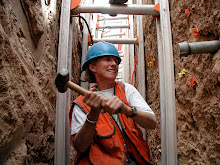The expansion of wholesale markets around the time of the Civil War placed a premium on rapid, large-scale production. The invention of the automatic pegging machine (1818), the sole cutting machine (1844), and the leather rolling machine (1846) helped satisfy growing demand, but their impact was limited. They facilitated the standardization of shoe sizes and shapes, but they did not affect key manufacturing processes such as binding, bottoming, upper leather cutting, and lasting. It was only with the adaptation of Elias Howe's sewing machine to the stitching of leather uppers, in the 1850s, that mechanization of the industry really began. [Source: The Endicott Johnson Corporation:19th Century Origins, Prof. Gerald Zahavi, Department of History, University at Albany, Copyright © 1984, 2009 by Gerald Zahavi.]
Tuesday, June 15, 2010
Mathias Johnson, shoemaker
Mathias Johnson (1811- aft 1880) is listed in the 1860-1870-1880 census rolls as a shoemaker in Greenwich, NY, which is near Cambridge, where many other Johnson ancestors lived. From what I can gather, Mathias was the older brother of William Melancthon Johnson (1834-1910). Likely, shoes in that era were still hand made in a small town in upstate New York. I have found several sites with information on shoemaking in the 18th and 19th centuries. Not until the end of the 19th century were shoes being made by machine. Shoes were usually made in small shops where each worker sat at a bench with his hammer, last, awls, pegs, string, wax, and bristles close at hand. During the 19th century, only farming occupied more people than shoe making. Shoe makers worked in many cases for an entrepreneur shoe manufacturer on a piecework basis. Manufacturers then shipped most of the shoes for sale to the southern and western United States, the western territories and even the Caribbean. Some of the shoes were sold in New York and England as well. By the 1830s Massachusetts alone produced over 15 million pairs of shoes and boots each year. Custom shoemakers might learn their trade by serving an apprenticeship as boys. In small shops where shoe makers only pegged the soles and heels to one style of shoe, considerably less skill was required and could be learned from a friend or relative in a few weeks.
The expansion of wholesale markets around the time of the Civil War placed a premium on rapid, large-scale production. The invention of the automatic pegging machine (1818), the sole cutting machine (1844), and the leather rolling machine (1846) helped satisfy growing demand, but their impact was limited. They facilitated the standardization of shoe sizes and shapes, but they did not affect key manufacturing processes such as binding, bottoming, upper leather cutting, and lasting. It was only with the adaptation of Elias Howe's sewing machine to the stitching of leather uppers, in the 1850s, that mechanization of the industry really began. [Source: The Endicott Johnson Corporation:19th Century Origins, Prof. Gerald Zahavi, Department of History, University at Albany, Copyright © 1984, 2009 by Gerald Zahavi.]
The expansion of wholesale markets around the time of the Civil War placed a premium on rapid, large-scale production. The invention of the automatic pegging machine (1818), the sole cutting machine (1844), and the leather rolling machine (1846) helped satisfy growing demand, but their impact was limited. They facilitated the standardization of shoe sizes and shapes, but they did not affect key manufacturing processes such as binding, bottoming, upper leather cutting, and lasting. It was only with the adaptation of Elias Howe's sewing machine to the stitching of leather uppers, in the 1850s, that mechanization of the industry really began. [Source: The Endicott Johnson Corporation:19th Century Origins, Prof. Gerald Zahavi, Department of History, University at Albany, Copyright © 1984, 2009 by Gerald Zahavi.]
Subscribe to:
Post Comments (Atom)

No comments:
Post a Comment